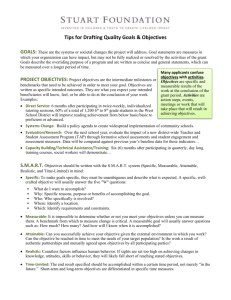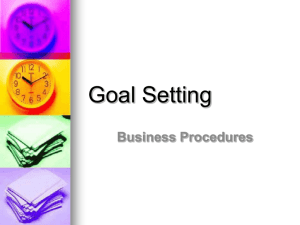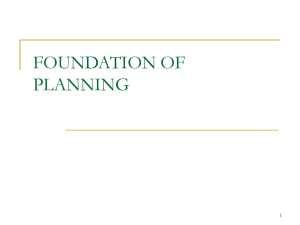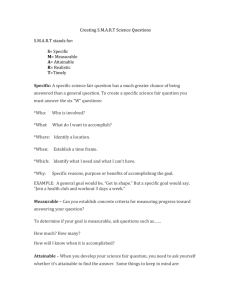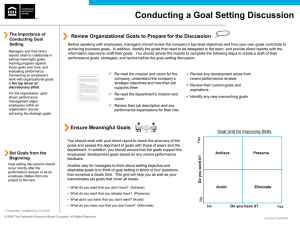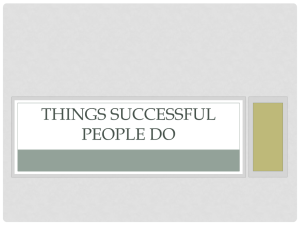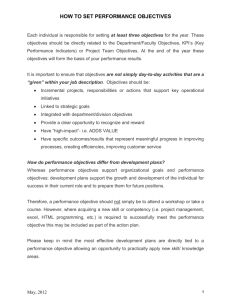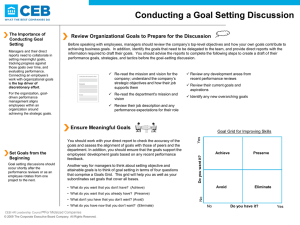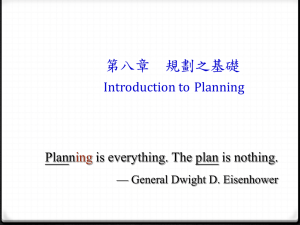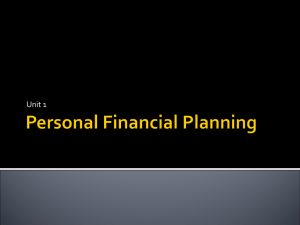Meeting Materials - Fora
advertisement
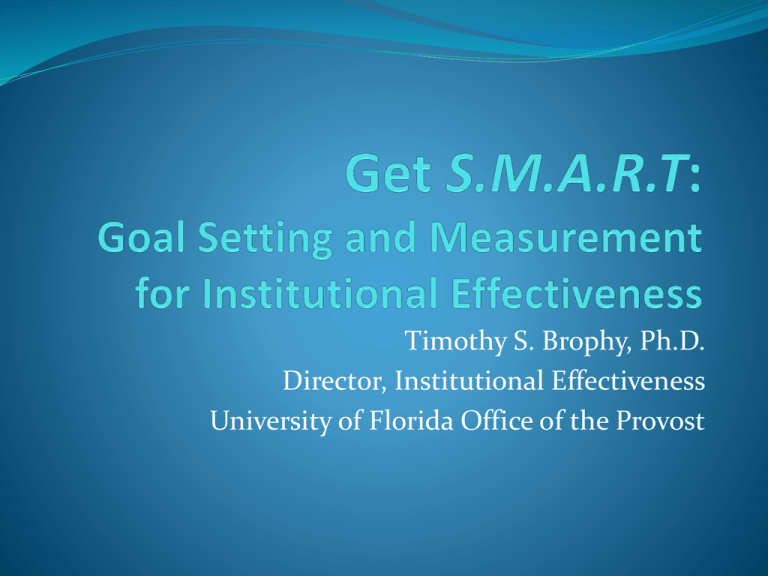
Timothy S. Brophy, Ph.D. Director, Institutional Effectiveness University of Florida Office of the Provost Today’s Goals Introduce the S.M.A.R.T. goal setting process Identify and apply steps for developing S.M.A.R.T goals Review the components of the 2013-14 Effectiveness Documentation Reports Institutional Effectiveness Core Requirement 2.5: The institution engages in ongoing, integrated, and institution-wide research-based planning and evaluation processes that (1) incorporate a systematic review of institutional mission, goals, and outcomes; (2) result in continuing improvement in institutional quality; and (3) demonstrate the institution is effectively accomplishing its mission Institutional Effectiveness CS 3.3.1: The institution identifies expected outcomes, assesses the extent to which it achieves these outcomes, and provides evidence of improvement based on analysis of the results in each of the following areas: (Institutional effectiveness) 3.3.1.1. educational programs, to include student learning outcomes 3.3.1.2. administrative support services 3.3.1.3. academic and student support services 3.3.1.4. research within its mission, if appropriate 3.3.1.5. community/public service within its mission, if appropriate Planning and Reporting Assessment and Institutional Effectiveness May – Establish Mission, Goals, and Outcomes Modify and Improve Data Reporting Assessment Planning Assessment Plans and Effectiveness Documentation Reports submitted for the next AY October Interpret and Evaluate the Data Implement the Plan and Gather Data Assessment Data, results, and use of results for previous AY entered into Compliance Assist! Documenting Effectiveness: Goals Annual unit reports on goals, action items, measures, and timelines for completion Academic corollary: Academic Assessment Plans Goals are critical to effectiveness One approach: S.M.A.R.T goal setting What does S.M.A.R.T. stand for? S = Specific M = Measurable A = Attainable R = Relevant T = Time-limited or timesensitive Goals must be Specific What: What do we want to accomplish? Why: Specific reasons, purpose or benefits of accomplishing the goal Who: Who is involved? Where: Identify a location Which: Identify requirements (essential attributes) and constraints Specific vs. Nonspecific Nonspecific goals Specific Goals We will grow our division. We will increase our We want good customer We will increase our reviews. We will communicate more with our stakeholders. personnel by 10% to manage our increased workload. customer satisfaction ratings by 5 points. We will send a monthly newsletter to our constituents. Goals must be measurable Need to establish concrete criteria for measuring progress toward the attainment of the goal If a goal is not measurable, it is not possible to know whether a team is making progress toward successful completion Measuring progress helps you to stay on track, reach target dates, and experience the success of achievement Setting measurable goals How much? How many? How will I know when it is accomplished? Some terms that complicate measurability Understand An internal process that is indicated by demonstrated behaviors Appreciate; value Internal processes that are indicated by demonstrated behaviors closely tied to personal choice Become familiar with Focuses assessment on “becoming familiar,” not familiarity Learn about, think about Not observable; demonstrable through communication or other demonstration of learning Become aware of, gain an awareness of Focuses assessment on becoming and/or gaining – not actual awareness Demonstrate the ability to Focuses assessment on ability, not achievement Measurable vs. Not measurable Not measurable Measurable We want to understand our We will hold monthly meetings stakeholders more fully. We will improve our Ph.D. programs. We want to plan more efficiently. with selected stakeholders to discuss their needs. Our Ph.D. students will write at least one paper worthy of publication in a tier one journal. We will develop a strategic plan for our college by June 2013. Goals must be attainable Goals must be realistic and attainable Attainable goals may stretch a team in order to achieve it, the goal is not extreme Goals are neither out of reach nor below standard performance, as these may be considered meaningless When you identify goals that are most important to you, you begin to figure out ways you can make them come true. You develop the attitudes, abilities, skills, and financial capacity to reach them According to theory, an attainable goal may cause goalsetters to identify previously overlooked opportunities to bring themselves closer to the achievement of their goals. Attainable goals How can the goal be accomplished? Does the goal represent an objective toward which you are both willing and able to work? Is the goal both high and realistic? Does the goal represent substantial progress? Attainable vs. Unattainable Unattainable/Unrealistic Attainable/Realistic In our unit of 50 employees, In our unit of 50 employees, we will double our personnel by June 2013. We will evaluate and make recommended changes to the Florida Greek Standards and to the Student Code of Conduct from February 14-28, 2013. we will hire 3 new employees by June 2013. We will evaluate and make recommended changes to the Florida Greek Standards and to the Student Code of Conduct by May 2013. Goals must be relevant Choose goals that matter. Many times you will need support to accomplish a goal: resources, a champion voice, someone to knock down obstacles. Goals that are relevant to your leadership, your division or college, and your organization will receive that needed support. Relevant goals (when met) drive the, department, division, and organization forward A goal that supports or is in alignment with other goals would be considered a relevant goal Relevant goals: Are worthwhile Are set at the right time Match other efforts/needs Are assigned to the right person/area/group Can be modified as needed Goals must be time-limited Goals must be grounded within a time frame, giving them a target date A commitment to a deadline helps a team focus their efforts on completion of the goal on or before the due date This part of the S.M.A.R.T. goal criteria is intended to prevent goals from being overtaken by the day-to-day crises that invariably arise in an organization A time-bound goal is intended to establish a sense of urgency. Time-limited goals Provide a timeframe for the completion of the goal Describe what can be done in 6 months, 6 weeks, or today Set a sequence of activities that will serve as benchmarks for achieving the goal What’s Coming Up – 2013-14 Effectiveness Documentation Report templates for 2013-14 will be issued in mid-March 2013 What’s new: Template for Goals Due May 15, 2013
